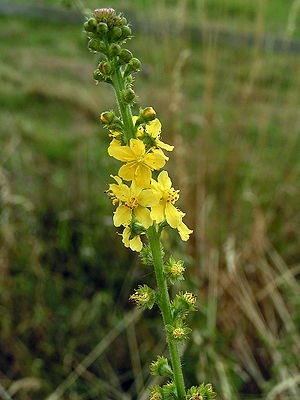Or menial
| Or menial | ||||||||||||
|---|---|---|---|---|---|---|---|---|---|---|---|---|

Common ormennig ( Agrimonia eupatoria ) |
||||||||||||
| Systematics | ||||||||||||
|
||||||||||||
| Scientific name | ||||||||||||
| Agrimonia | ||||||||||||
| L. |
The ormennige ( Agrimonia ) are a genus of plants from the subfamily of the Rosoideae within the family of the rose plants (Rosaceae).
description

Ormennig species are large, perennial herbaceous plants that grow from a rhizome . The stems are hairy. The alternate, stalked leaves are unpaired pinnate and up to 25 centimeters long. The leaflets are serrated. The large stipules that have not grown together are fused with the base of the petioles.
The axillary or terminal, mostly interrupted, racemose inflorescences usually contain many flowers. Two lobed prophylls arise from the base of the peduncle . The very small, five-fold, radial symmetry flowers are hermaphroditic. The flower cup is almost closed at its throat by a dome-shaped disc with hooked spikes on the outside. An outer cup is missing. The five sepals lie on top of each other like roof tiles and close over the developing fruit after the flowering period has ended. The five petals are mostly yellow, rarely white. The flowers have five to ten, rarely up to twenty stamens . Each flower contains two free carpels . The stylus are thread-shaped.
Usually two, sometimes just one, achenes with thin, leathery pericarp and spines develop per flower - enclosed in the calyx . The outer skin of the seeds is membranous.
The chromosome numbers are 2n = 28 or 56, in hybrids 42.
distribution
The genus Agrimonia is widespread in Europe and Asia and penetrates as far as Sri Lanka and Java . A few species are also found in North America to Mexico, one in Haiti and a few in Brazil . Mennige are neophytes in some countries outside of their actual range , for example in South Africa.
The genus Agrimonia is native to temperate zones , in the tropics it retreats to montane altitudes. While some species grow as " weeds ", the majority are mostly found in open vegetation.

use
The plant, especially the root, was previously used to dye wool or cotton yellow. The later in autumn the plant is harvested for coloring, the darker the yellow will be. The lightfastness is referred to as medium.
Some species are used as medicinal plants.
species
The genus Agrimonia includes about ten to 15 species, including:
- Agrimonia coreana Nakai : It occurs from eastern Russia via Japan and Korea to the Chinese provinces of Jilin, Liaoning, Shandong and Zhejiang.
- Ordinary Odermennig or Kleiner Odermennig ( Agrimonia eupatoria L. ), Origin: Europe, Asia, North Africa
- Agrimonia gryposepala Wallr. : It is widespread from California to eastern North America via the Mexican mountains (Chiapas) to Guatemala.
- Agrimonia incisa Torr. & A.Gray : It is only found in the southeastern United States.
- Agrimonia nipponica Koidz. : It only occurs in Japan.
- Agrimonia parviflora Aiton : It is widespread in eastern North America.
- Agrimonia pilosa Ledeb. : It is widespread in Eurasia from Eastern Europe, northern India, Bhutan, Sikkim, Nepal, Myanmar, northern Laos, northern Thailand, Mongolia, Russia, all of China, northern Vietnam, Korea, Japan.
- Großer Odermennig or Fragrant Odermennig ( Agrimonia procera Wallr. ), Origin: Europe
- Agrimonia pubescens Wallr. : It is common in North America.
- Agrimonia repens L .: The home is Turkey and Iraq and it is naturalized in Europe.
- Agrimonia rostellata Wallr. : The home is in the USA.
- Agrimonia striata Michx. : It is distributed from California to eastern North America and the Mexican mountains.
proof
- Li Chaoluan (Li Chao-luang), Hiroshi Ikeda, Hideaki Ohba: Agrimonia , p. 382 - same text online as the printed work , PDF 4.6 MB , In: Wu Zheng-yi & Peter H. Raven (eds.): Flora of China , Volume 9 - Pittosporaceae through Connaraceae , Science Press and Missouri Botanical Garden Press, Beijing and St. Louis, 2003. ISBN 1-930723-14-8 . (Sections Description and Distribution)
- EJ Mendes: Rosaceae in Flora Zambesiaca , Volume 4, Kew Publishing at the Royal Botanic Gardens Kew, 1978, online.
- C. Kalkman: Rosaceae. In: Klaus Kubitzki (Ed.): The Families and Genera of Vascular Plants - Volume VI - Flowering Plants - Dicotyledons - Celastrales, Oxalidales, Rosales, Cornales, Ericales , 2004, pp. 361–362, ISBN 978-3-540- 06512-8
Web links
- Differentiation between local Odermenninge [1]
Individual evidence
- ↑ E. Prinz: "Dyeing plants - instructions for dyeing, use in culture and medicine" Verlag Schweizerbart, Stuttgart 2014 ISBN 978-3-510-65291-4 , p. 57.
